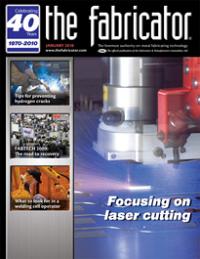Editor-in-Chief
- FMA
- The Fabricator
- FABTECH
- Canadian Metalworking
Categories
- Additive Manufacturing
- Aluminum Welding
- Arc Welding
- Assembly and Joining
- Automation and Robotics
- Bending and Forming
- Consumables
- Cutting and Weld Prep
- Electric Vehicles
- En Español
- Finishing
- Hydroforming
- Laser Cutting
- Laser Welding
- Machining
- Manufacturing Software
- Materials Handling
- Metals/Materials
- Oxyfuel Cutting
- Plasma Cutting
- Power Tools
- Punching and Other Holemaking
- Roll Forming
- Safety
- Sawing
- Shearing
- Shop Management
- Testing and Measuring
- Tube and Pipe Fabrication
- Tube and Pipe Production
- Waterjet Cutting
Industry Directory
Webcasts
Podcasts
FAB 40
Advertise
Subscribe
Account Login
Search
2010 Capital Spending Report indicates rebuilding set to begin
After a tumultuous 2009, metal fabricating companies ready to look forward
- By Dan Davis
- January 14, 2010
- Article
- Shop Management
For those metal fabricators that have wondered if their competitors were operating at similar capacity levels in 2009, you can rest easier at night. More than likely, those companies have been as slow as your company.
FMA Communications' 2010 Capital Spending Report reveals that facilities, ranging in size from 1-19 employees to companies with more than 1,000 employees, have been operating at 66 percent to 69 percent capacity, not quite the levels most remember fondly. To put that figure in perspective, survey respondents in 2009 indicated that their companies were operating at around 80 percent capacity.
Of course, this story is nothing new to the metal fabricating and forming community. However, it does reinforce what everyone knows. It's rebuilding time.
But before we jump into the survey results, it helps to understand how the Capital Spending Report was put together. In the summer of 2009, a random sample of 10,000 subscribers to FMA Communications publications were sent a questionnaire. Following two e-mail reminders in some instances, approximately 500 surveys were completed and returned. FMA Communications then used an algorithm, refined by machining industry publisher Gardner Publications, to turn the raw data numbers into projections.
On the basis of those calculations, you can see that some are ready to jump back into the competitive fray. Figure 1). suggests that 30 percent are ready to increase spending on capital equipment, while only 26 percent plan to decrease spending. If you look back to 2008, about 51 percent planned to increase capital spending, leaving the impression that metal fabricators may be headed in a positive direction as they climb their way back to the robust days of 18 months ago.
Projected Equipment Expenditures
The survey suggests that metal fabricators plan to spend about $1.337 billion on metal fabricating and forming equipment in the U.S. in 2010. Again, that pales in comparison with the $2.221 billion that was expected to be spent in 2008, but still holds some good news, particularly as you look at what types of equipment are being targeted (see Figure 2).
Fabricators are showing interest in cutting-edge equipment in a way that overshadows demand for more traditional metal fabricating and forming technology. For example, $120.1 million is expected to be spent on 2-D and 3-D laser cutting machines in 2010, which is only slightly lower than the $135.9 million that was projected to be spent in 2008. Interest in servo stamping presses is much smaller by comparison, but interest in state-of-the-art technology remains relatively strong as well; the $8.6 million expected to be spent on this servo technology in 2010 is down only slightly from the $12.3 million projected to be spent two years ago.
If that's not impressive, consider the projected spending declines in other equipment areas, some of which are marked with their own state-of-the-art products. Projected spending for welding power supplies is projected to drop by $137 million when 2010 survey results are compared to 2008's, $58 million for hydraulic press brakes, and $51.7 million for band saws.
When asked the principal overall motive for spending on capital equipment in 2010, survey respondents provide a glimpse into their interest in cutting-edge equipment. In companies with 249 or fewer employees, slightly more than 20 percent indicate an interest in increasing machine capacity.
Who's Spending the Money?
If you look at actual North American Industry Classification System (NAICS) codes, the Fabricated Metal Product Manufacturing sector represents the largest chunk of companies planning for capital equipment expenditures in 2010 (see Figure 3). The Machinery Manufacturing and the Transportation and Equipment Manufacturing sectors represent the next largest groups.
A geographic breakdown of the 2010 capital spending plans reveals that five states—California, Ohio, Texas, Pennsylvania, and Illinois—represent 35.3 percent of the total number of plants planning to purchase this year. When you expand that list to the top 10 states, which includes Wisconsin, Michigan, Minnesota, Indiana, and North Carolina, the percentage rises to 59.
Even with the economic turmoil the recession caused in the Midwest, the Rust Belt states still are vital areas for manufacturing. Michigan, Wisconsin, Illinois, Indiana, and Ohio still account for 28.7 percent of the total number of plants planning to purchase equipment in 2010. That's followed by the Plains States—North Dakota, South Dakota, Nebraska, Kansas, Minnesota, Iowa, and Missouri—which account for 14.3 percent.
About the Author

Dan Davis
2135 Point Blvd.
Elgin, IL 60123
815-227-8281
Dan Davis is editor-in-chief of The Fabricator, the industry's most widely circulated metal fabricating magazine, and its sister publications, The Tube & Pipe Journal and The Welder. He has been with the publications since April 2002.
subscribe now

The Fabricator is North America's leading magazine for the metal forming and fabricating industry. The magazine delivers the news, technical articles, and case histories that enable fabricators to do their jobs more efficiently. The Fabricator has served the industry since 1970.
start your free subscription- Stay connected from anywhere

Easily access valuable industry resources now with full access to the digital edition of The Fabricator.

Easily access valuable industry resources now with full access to the digital edition of The Welder.

Easily access valuable industry resources now with full access to the digital edition of The Tube and Pipe Journal.
- Podcasting
- Podcast:
- The Fabricator Podcast
- Published:
- 04/16/2024
- Running Time:
- 63:29
In this episode of The Fabricator Podcast, Caleb Chamberlain, co-founder and CEO of OSH Cut, discusses his company’s...
- Industry Events
16th Annual Safety Conference
- April 30 - May 1, 2024
- Elgin,
Pipe and Tube Conference
- May 21 - 22, 2024
- Omaha, NE
World-Class Roll Forming Workshop
- June 5 - 6, 2024
- Louisville, KY
Advanced Laser Application Workshop
- June 25 - 27, 2024
- Novi, MI
































